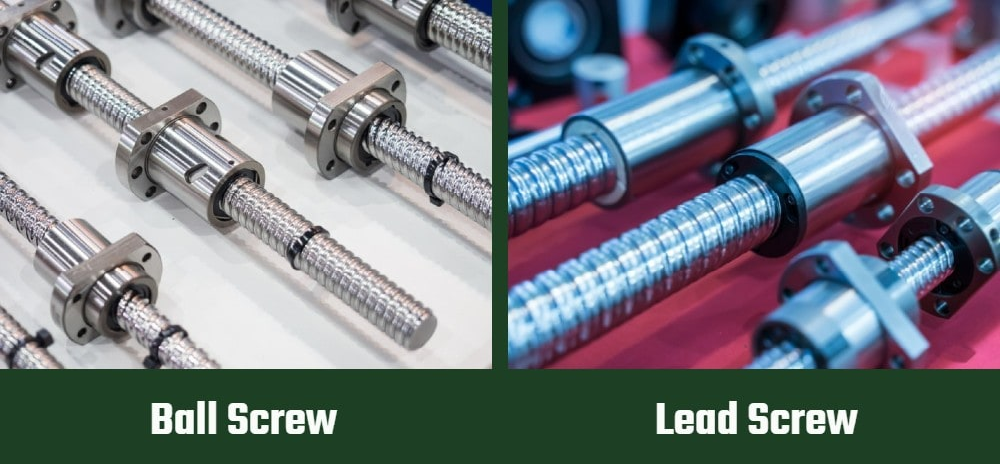
Lead Screws vs. Ball Screws: Choosing the Right Option for Automation
In the world of automation and linear motion systems, lead screws and ball screws play crucial roles. Both mechanisms are commonly used for converting rotational motion into linear motion, but they have distinct characteristics that make them suitable for different applications. Understanding the differences between lead screws and ball screws is essential for choosing the right option to meet your automation needs.
Basic Principles:
Lead Screw: A lead screw consists of a threaded shaft (screw) and a nut that contains matching threads. The screw is rotated, and as it turns, it moves linearly by engaging with the threads of the nut. The nut remains stationary during operation.
Ball Screw: A ball screw also comprises a screw and a nut, but in this case, the nut incorporates a series of recirculating ball bearings. The balls act as rolling elements between the screw and the nut, reducing friction and enabling smoother motion. As the screw rotates, the balls circulate within the nut, allowing for efficient linear movement.
Efficiency and Precision:
One of the main differences between lead screws and ball screws lies in their efficiency and precision:
Lead Screw: Lead screws typically have lower efficiency and precision compared to ball screws. They exhibit more backlash, which refers to the slight linear play or clearance between the screw and the nut. Backlash can lead to positioning errors and reduced accuracy, especially in applications requiring high precision.
Ball Screw: Ball screws are designed to provide higher efficiency and precision. The recirculating ball bearings reduce friction, resulting in improved efficiency by converting a greater proportion of rotational motion into linear motion. The elimination or reduction of backlash enhances positioning accuracy, making ball screws ideal for applications demanding precise positioning and repeatability.
Load Capacity:
The load capacity of a linear motion system is an important consideration in automation:
Lead Screw: Lead screws are suitable for applications with relatively lower load requirements. They are commonly used in light-duty systems or applications where precise positioning is not critical, such as manual adjustment mechanisms or simple automation tasks.
Ball Screw: Ball screws excel in applications that demand high load capacity. The presence of the recirculating ball bearings enhances load-bearing capability, allowing ball screws to handle heavier loads without compromising on performance or accuracy. They are commonly utilized in industrial automation, CNC machines, robotics, and other applications where precision and high load capacity are essential.
Speed and Efficiency:
The speed and efficiency of linear motion systems can significantly impact overall performance:
Lead Screw: Lead screws are typically limited in terms of speed due to the higher friction between the screw and the nut. The presence of backlash can further affect efficiency, as it may introduce jerky or uneven motion. Therefore, lead screws are more suitable for applications requiring slower speeds or where speed is not a critical factor.
Ball Screw: Ball screws excel in high-speed applications. The rolling contact between the balls and the screw reduces friction, enabling smoother and faster linear motion. The elimination of backlash allows for precise and consistent movement at high speeds. As a result, ball screws are preferred in applications that require rapid and accurate positioning.
Cost Considerations:
Cost is an important factor when selecting between lead screws and ball screws:
Lead Screw: Lead screws are generally more cost-effective compared to ball screws. They are simpler in design and construction, requiring fewer components. If your application does not demand high precision or load capacity, a lead screw can provide a cost-effective solution.
Ball Screw: Ball screws tend to be more expensive due to their higher precision, load capacity, and efficiency. The incorporation of ball bearings and the need for tighter manufacturing tolerances contribute to the increased cost. However, when precision, load capacity, and high-speed operation are vital, the benefits of a ball screw often outweigh the higher upfront investment.
In summary, lead screws and ball screws each have distinct advantages and are suited for different automation applications. Lead screws are more cost-effective and suitable for lighter loads and slower speeds, while ball screws offer higher precision, load capacity, and speed capabilities. Assessing your specific requirements in terms of load capacity, precision, speed, and budget will help you make an informed decision about which type of screw mechanism is the best fit for your automation needs.